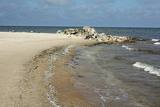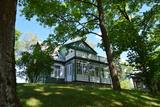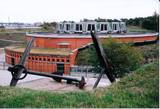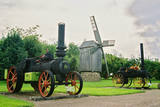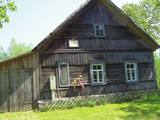| Nr | Name | Beschreibung |
|---|---|---|
|
Der alte Leuchtturm vom Kap Kolka – am Ende des Kaps kann man das
von Wellen abgespülte Gemäuer des im 16. Jahrhundert gebauten und
mehrmals erneuerten Leuchtturmes sehen. Nach jedem großen Sturm und
kälterem Winter werden diese aber immer kleiner. Früher befanden sich die
Trümmer tiefer im Festland, doch jetzt verschwinden sie langsam unter Wasser.
|
||
|
The hosts produce mixtures of dried herbs and vitamin tea in a full cycle - from seeds to a packet of spices. The farm beds and greenhouses grow a wide range of vegetables and herbs - dill, onions, garlic, chives, mint, sage, thyme, coriander, hyssop, tarragon, peppermint, chili, basil. Also used wild plants - nettle, gooseberry, viburnum, dandelion, yarrow, oregano. |
||
|
Jau pēc dievnama veidola var spriest, ka vēl ne tik sen – padomju laikos ēka bija izmantota citām vajadzībām. Pēc 2. pasaules kara to atsavināja draudzei, bet torni – uzspridzināja, dievnamā ierīkojot noliktavu. 20. gs. deviņdesmitajos gados draudze uzsāka baznīcas atjaunotni un tagad tā kalpo savam pamatmērķim. |
||
|
Auf dem Hof befindet sich die Gaststube „Agluona“ in der Zichorienkaffee angeboten wird und Gerichte aus Kleinlitauen und Niederlitauen. Zudem werden auch Verkostungen veranstaltet. |
||
|
Die museale Gedenkstätte für A. Baranauskas und A. Vienuolis-Žukauskas wurde 1927 begründet. Hier wird Material gesammelt, archiviert und gezeigt, welches die Kultur und Literatur der Gegend um Anykščiai, die Geschichte, die Entwicklung von Landwirtschaft und Technik in der Region zeigt. Die Besucher können das ganze Jahr über durch die Hügel des Schriftstellergedächtnisparks spazieren. |
||
|
Das Speisehaus Lümanda in alter Kirchschule bietet Ihnen leckeres Bauernmenü an. Beim Kochen wird nur biologisch reine Rohstoffe aus umliegenden Feldern benutzt. Fisch stammt von örtlichen Fischern. Nebenan gibt es ein Handarbeitsgeschäft. |
||
|
Der Landgutkomplex (mehr als 12 Gebäude) und der Park von Veselava (deutsch Wesselshof) haben sich bis heute fast vollständig erhalten. Das Schloss des Landgutes ist in den 1840er Jahren auf einer eiförmigen Insel gebaut worden, die von allen Seiten von einem Graben umschlossen wird. So eine Lage des Herrenhauses hat eine mittelalterliche Festung nachgeahmt. Im Herrenhaus befinden sich jetzt die Gemeindeverwaltung, eine Bibliothek und die Post. Hier kann man eine Führung durch das Landgut und seine nähere Umgebung bestellen. Mit dem Landgut von Veselava sind Erzählungen über den Baron und das schöne Mädchen Rasa Kausule verbunden, die sich ähnlich wie die Rose von Turaida der Laune des Gutsverwalters nicht unterworfen hat. Um die ganze Geschichte zu hören, muss man nach Veselava fahren. |
||
|
Atrodas Amatas ielejas augstajā krastā, autoceļa (A 2) Rīga – Veclaicene malā. Plašs ēdienu klāsts, lielas porcijas, iecienīta tālbraucēju šoferu maltītes ieturēšanas vieta. |
||
|
Noch vor 20 – 30 Jahren wohnten in Roja Ilga Veidemane und LaimonisVeidemanis, die gehörlose Leute waren und schafften mit großer Liebe Segelschiffmodelle verschiedener Größe. Ein unrealisierter Traum über alte größe Schiffe und das weite Meer lag zu Grunde des Schaffens der Segelschiffmodelle. Diesen Leuten war leider nicht vergönnt, das weite Meer zu befahren. Die Segelschiffmodelle wurden mit hoher Präzision, Sorgfalt und großer Liebe gemacht, ohne irgendwo Geheimnisse des Schaffens der Segelschiffmodelle zu erlernen. Diese Sammlung hat jetzt die Enkelin von Laimonis Veidemanis geerbt, die diese wunderschöne Sammlung und das Bemühen des Großvatters einem breiten Publikum zeigen möchte. Die Gastgeberin erzählt den Besuchern über das Schaffen der Segelschiffmodelle. (Die Quelle: Roja TIZ) |
||
|
Schon seit der früheren Zeiten – ein Platz von der militärischen und strategischen Bedeutung. Für den Schutz des Hafens von Klaipeda wurde 1866 von preussischer Militär den Bau einer Festung angefangen. Im Laufe des 2.Weltkriegs wurde die Festung in die Luft gesprängt. Die Renovierung begann 1979. |
||
|
Diese Gaststäte liegt an einem landschaftlich sehr schönen Ort – im Urstromtal des Flusses Abava, zwischen Kandava und Sabile. Die Gaststätte befindet sich in einem historischen Gebäude mit einem Mantelschornstein, der einer der größten im Baltikum ist. Nebenan befindet sich eine Erholungsstätte für Wassertouristen. Lettische Küche: Kalte Rote-Beete-Suppe, Suppe aus Fleischbällchen, Ampfersuppe, Sauerkrautsuppe, Hähnchenleber, hausgemachte Frikadellen, geräucherte Schweinerippen, gebratenes oder gegrilltes Schweinefleisch, Kartoffelpfannkuchen mit Sauerrahm, dünne Pfannkuchen, Kräutertees. Das besondere Gericht: Mit geräuchertem Fleisch, Quark und Zwiebeln gefüllte Klöße. |
||
|
Das Estnische Landwirtschaftsmuseum befindet sich in der Nähe von Tartu, im Gutshof Ülenurme. |
||
|
A friendly place for families, children and all interested parties. You can go on a tour or individually look at and learn about marmosets. |
||
|
The owners began to grow watermelons in 1997, using types that are appropriate for the climate in Latvia. Of particular interest are watermelons which have a yellow interior. The largest watermelon that the farm produced weighed 11 kg. During the season, you can purchase watermelons and hear advice from the owners. |
||
|
200 m attālumā no Gulbenes – Madonas ceļa mežainā nogāzē iegūlis 2,4 m augstais akmens. Tā lēzenajā virsmā iekalta ap metru gara, 0,3 m plata un ap 4 cm dziļa iedobe, bet akmens šķautnē - pakāpieni. Uzskata, ka šis ir sens kultakmens, pie kura ziedots. Lai nokļūtu līdz akmenim, vasaras otrajā pusē var nākties brist pa garu zāli. |
||
|
Eins der tiefsten Flussstromtäler Lettlands (bis zu 50 m). Entlang des rechten Ufers des Flusses ist eine Naturpfad eingerichtet. |
||
|
The House-Museum of the writer Michael Narics. Reveal the history of political repressions in the
USSR and Soviet Latvia; see creative works of the winners of competition organized by M. Narics Educational
Center.
Working hours: on request |
||
|
The Krimulda Castle was built in the latter half of the 13th century. It was located where the right bank of the ancient Gauja River valley is split by the deep Vikmeste ravine. The castle was owned by the council of archbishops from Rīga, and it was an impressive structure with a large interior courtyard and a defensive wall that was 1.5 m thick. The Swedish military blew up the castle when retreating in 1601. Today the castle hill is forested, and only a small fragment of the castle wall can still be seen. It is near the ruins that you will find the Sigulda aerial tram and the Krimulda serpentine road – the only object of its kind in the Baltic States. |
||
|
Ļoti ainavisks ezers, uz kuru paveras lieliskas ainas no Vidzemes augstienes pauguriem. Te jāatceras latviešu teika par Ineša un Alauksta strīdu, kā rezultātā Inesis dabūja pliķus – salas, kurām (sešām) tāpat kā Sproģu pussalai ir dabas lieguma statuss. |
||
|
Der Park des Gutes Stelmužė wurde Mitte des 18. Jh. südlich vom See Stelmužė angelegt. Von allen Seiten führen gewundene Pfade zu der auf dem Hügel stehenden Jesus-Kreuz-Kirche. In der Baumschicht dominieren Linden, Ahorn, Ulmen, Birken, Fichten, Eschen, Kiefern. Am Fuß des Hügels befinden sich der Glücksbrunnen und man kann die Eichenallee entlang schlendern. Prunkstück ist aber zweifellos die Stelmužė-Eiche, die älteste und dickste in Litauen wachsende Eiche und sogar eine der ältesten Eichen in Europa. Man vermutet, dass der Baum etwa 1500-2000 Jahre alt ist, der Stammdurchmesser beträgt 3,5 m (um den Stamm zu umfassen benötigt am 8 bis 9 Leute), die Höhe 23 m. |
||
